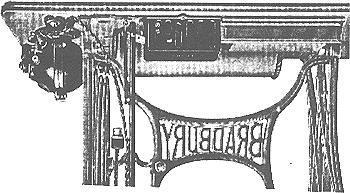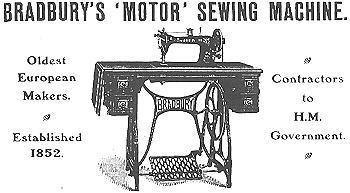Was this Really the First Electric Sewing Machine?

by Graham Forsdyke
ISMACS News
Issue 55
April 1997
THE QUESTION arose a couple of weeks back on the ISMACS Internet Digest about which company first introduced electric machines.
Patent claims were made well back into the last century for electrified machines, but what we are talking about here is a ready-to-plug-in domestic machine from a major manufacturer and freely available from the local agent.
National in the USA made a claim in its anniversary brochure published in 1939 that the first machine came from the Illinois factory in 1917.
Whilst this may have looked good in print, it was far from the truth. Fact is that the English Bradbury company in Oldham, Manchester, had an electric machine up, running and on offer to the public as far back as 1903.

Bradbury, proud of its "Oldest European Makers" logo - Singer beat it by a few months world-wide - listed a mains-powered No. 6 machine for £15 15s (£15.75; $27).
Most homes which had electricity at the time - and there were not many of them - had no wall outlets, simply lighting sockets in the ceilings. Therefore the Bradbury came with a length of flex and a plug so that it could be connected to "an ordinary incandescent lamp holder".
The actual motor was mounted under the treadle table and connected via a rheostat to the pedal, which acted as on-off switch and speed controller. Alternatively, the switch assembly could be mounted on the table top for hand operation.
Bradbury pointed out that when ordering the "Motor Sewing Machine" it was necessary to state what voltage was required.





